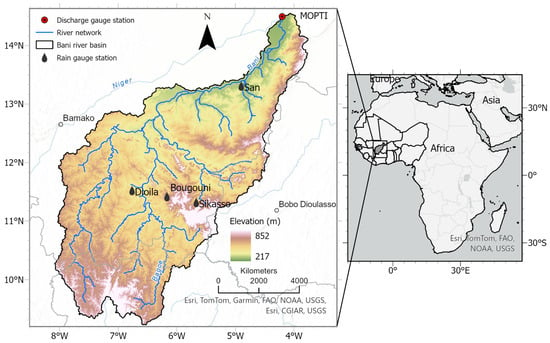West Africa faces growing challenges related to climate variability and human-induced changes, which significantly impact its river systems. Among these challenges are alterations in rainfall patterns and river flows, driven by factors such as dam construction, land-use changes, and global climate change [1,2]. These dynamics are particularly critical in regions where water resources play a central role in sustaining agriculture, fisheries, and livelihoods for millions of people [3]. While research on West Africa’s river systems has primarily focused on larger and better-documented basins such as the Senegal and Niger, the Bani River Basin has received comparatively less attention, despite its critical role as a tributary of the Niger River and its unique hydrological vulnerabilities [4]. Understanding and quantifying these trends is crucial for ensuring sustainable water resource management and mitigating the effects of hydrological extremes [5]. The hydroclimatic variability in West Africa has been extensively documented, with research highlighting significant temporal and spatial changes in rainfall and river flow across the region. Studies have reported an increase in extreme rainfall events and river discharge in the Senegal River Basin, with a notable shift to wetter conditions [6]. Significant transitions in annual rainfall patterns have also been identified, with periods of drought followed by partial recovery after 1994 [7]. These findings align with broader studies demonstrating the sensitivity of river basins like the Bani to both natural climate cycles and anthropogenic influences [8,9]. However, the Bani River Basin (BRB) faces specific challenges due to its semi-arid environment, reliance on rain-fed agriculture, and significant human pressures from land-use changes and water infrastructure development. Unlike larger basins, it lacks the extensive monitoring and data resources necessary for understanding its hydrological behavior, making this study particularly important [10]. Additionally, the interplay between rainfall variability and dam construction has revealed significant alterations in hydrological regimes that are likely mirrored in the Bani Basin [11]. Together, these studies underscore the complex drivers of hydrological change across West Africa, including climatic and human-induced factors.
The BRB itself has been the subject of targeted research, emphasizing its unique hydrological characteristics and vulnerabilities. Hydrological models have been used to assess the basin’s response to rainfall variability, identifying substantial impacts on river flow and water resource availability [8]. The intricate interactions between surface water and groundwater in the basin have provided critical insights into its hydrological processes [9]. These findings are complemented by simulations of the hydrological dynamics under varying climatic and land-use scenarios, which highlight the basin’s susceptibility to environmental changes [12]. This study also contributes to addressing these knowledge gaps by focusing specifically on the rainfall and river flow trends in the Bani Basin, leveraging statistical methods that provide a detailed temporal analysis. Such an approach offers a more nuanced understanding of its hydroclimatic variability compared to existing regional studies [13]. Additionally, climate change projections for river flows across West Africa emphasize the heightened vulnerabilities of semi-arid regions like the Bani River Basin [14].
The challenges faced by the BRB are not unique but are indicative of broader trends across West African river basins. Recent works demonstrate the interconnection between regional climate patterns, anthropogenic interventions, and hydrological responses [6,11]. For example, the construction of dams has been shown to significantly modify flow regimes and sediment transport, which are key concerns in the BRB. Furthermore, long-term studies on rainfall trends provide a foundation for understanding the basin’s hydrological variability [3,8].
Despite these advances, the BRB remains less studied than major basins like the Senegal and Niger. This work is novel in its comprehensive approach to assessing both natural and anthropogenic factors driving hydrological change in the Bani River Basin. Unlike previous studies, which have largely focused on regional-scale impacts, this research integrates local-scale hydrological data and statistical techniques to uncover trends and transitions specific to the BRB [15]. This study aims to fill this gap by conducting a comprehensive assessment of the trends and significant changes in rainfall and river flow within the BRB. By integrating historical observations and statistical techniques, this research seeks to provide a deeper understanding of the basin’s hydroclimatic dynamics. The outcomes will not only contribute to scientific knowledge but also inform sustainable water resource management and adaptation strategies, addressing the challenges posed by climate variability and human interventions in the region.
Source link
Fousseini Kouyaté www.mdpi.com


